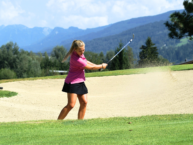Guest Author, Kathy Ekdahl of Personal Best Personal Training
Core training has been a buzz word for decades, but many people are still not optimizing their core training due to outdated exercises or a limited understanding of what movements our core is involved in (trick answer- our core is involved in everything!).

When it comes to golf, core strength is essential for a powerful and safe swing. During the golf swing, your core muscles, especially your anterior core (aka abdominals), do many different functions. When you plan your core exercises, you should thus incorporate exercises that enhance the core muscles as they are used in golf. And while golf has very high-level needs for a strong core, your every day life will also greatly benefit from a wide variety of core exercises.
To get on the same page, let’s first review what the core muscles are and what they do.
Your core muscles are all the muscles that attach to and stabilize the spine and the pelvis (especially your lumbar spine-your center of gravity) so that your arms and legs can move around your trunk during the functional movements of life. Your core also supports some of the organs of the torso and creates essential intrabdominal pressure to act as a supportive girdle to protect your spine. Your diaphragm and pelvic floor muscles are also your core! So, your core muscles include all of the abdominals, deep and surface, glute muscles and hip muscles, and many of the muscles along the back of the body. Your “core” is not just your abdominals.
Now, think about how your arms and legs move around your torso during the golf swing. Keeping a proper spine angle as you swing the club is the main job of the core, and especially the abdominals. First and foremost, your abs act as an anchor for either your upper torso or pelvis, so that you can create separation of these body parts during different phases of the golf swing. This is how we create “coil” and potential power for high club head speed. So, your abs act isometrically during the golf swing, starting with address. This means we need to program isometric abdominal holds as our step 1. Exercises like planks, dead bugs, side planks, bird dogs, paloff pressing are ground zero for a great golf swing.
The abs also act as a conduit for your weight shift. They translate ground forces up to your hands and the club. On the downswing, your lower spine flexes (tucks under) prior to ball strike. This is an important movement to spare the spine. Short range of motion crunches or reverse curls can build this movement, but don’t fall into the trap of only doing spinal flexion work like crunches or bicycles. (And, true “sit-ups” are not really necessary and may cause more problems than solve them. I’m not a fan). You can, and should, create this same “tuck under” for many of your isometric abdominal holds like planks or bear crawl positions.
The downswing and ball strike also require adequate hip rotation and hip extension (pushing hips forward and towards the target), so mobile hips and strong glutes and hip rotators should be a major goal of your core training regimen. Keep your hips mobile with hip circles, glute and hip stretches and other hip mobility drills. Keep your glutes strong with bridges, dead lifts, lunges and lateral hip strengthening.
While there are specifics exercises to strengthen individual core muscles, many classic strength training movements strengthen the core as well. Push-ups, dead lifts, farmer’s walks, KB swings, Turkish get ups, squats and lunges all access the core through your need for stability during these movements. Med ball throws, scoops and chops challenge the stability of your center of gravity with speed, just like in golf. They are all perfect whole body exercises to access the core with golf-like strength and endurance exercises.
Lastly, keep in mind that there is no need to do extreme core exercises on unstable surfaces like physio balls or Bosu balls. You do not build more strength utilizing these tools. It’s fun to work on balance and stability, but research demonstrates that it is not better for strengthening than challenging yourself on stable surfaces. The earth is not unstable. It is uneven. If you want to challenge your core on uneven surfaces, go for it. But balancing on a physio ball or doing biceps curls on a Bosu ball is not the way to strengthen your core. And the risk of falling far outweighs any physiological benefit.
About Kathy Ekdahl

Kathy is a personal trainer and a Certified Strength and Conditioning Specialist (CSCS) with the National Strength and Conditioning Association (NSCA). Kathy is the author of Getting Golf Ready – An Introduction to Golf Fitness, available through Amazon. She has been featured as a golf fitness expert in IDEA magazine, a trade journal for the fitness industry, and offers golf fitness workshops to golf clubs and health clubs throughout Massachusetts.Find out more at her website: https://personalbestpersonaltraining.com/






